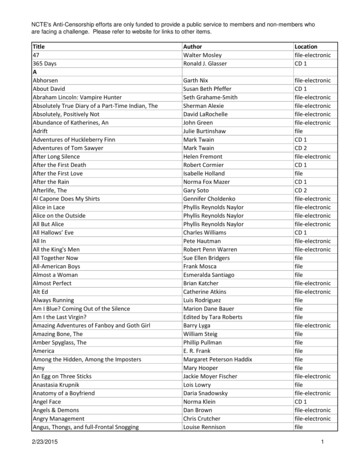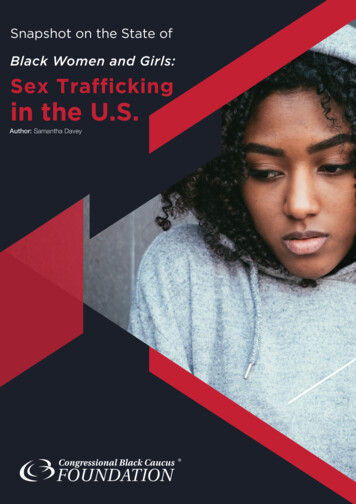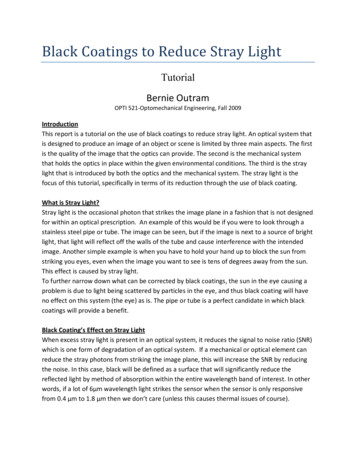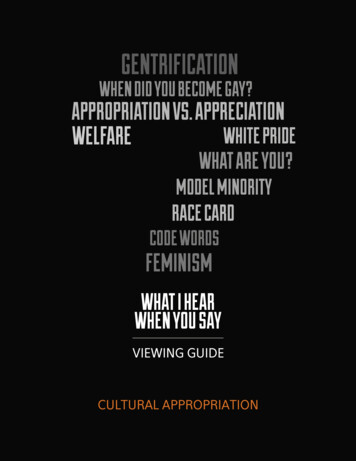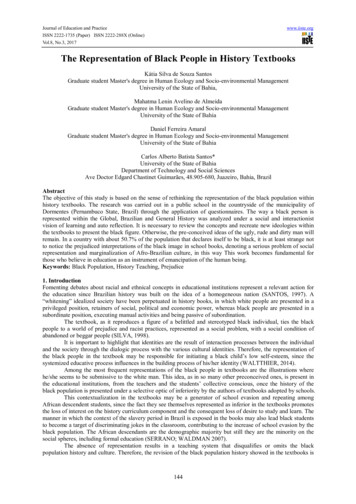
Transcription
Journal of Education and PracticeISSN 2222-1735 (Paper) ISSN 2222-288X (Online)Vol.8, No.3, 2017www.iiste.orgThe Representation of Black People in History TextbooksKátia Silva de Souza SantosGraduate student Master's degree in Human Ecology and Socio-environmental ManagementUniversity of the State of Bahia,Mahatma Lenin Avelino de AlmeidaGraduate student Master's degree in Human Ecology and Socio-environmental ManagementUniversity of the State of BahiaDaniel Ferreira AmaralGraduate student Master's degree in Human Ecology and Socio-environmental ManagementUniversity of the State of BahiaCarlos Alberto Batista Santos*University of the State of BahiaDepartment of Technology and Social SciencesAve Doctor Edgard Chastinet Guimarães, 48.905-680, Juazeiro, Bahia, BrazilAbstractThe objective of this study is based on the sense of rethinking the representation of the black population withinhistory textbooks. The research was carried out in a public school in the countryside of the municipality ofDormentes (Pernambuco State, Brazil) through the application of questionnaires. The way a black person isrepresented within the Global, Brazilian and General History was analyzed under a social and interactionistvision of learning and auto reflection. It is necessary to review the concepts and recreate new ideologies withinthe textbooks to present the black figure. Otherwise, the pre-conceived ideas of the ugly, rude and dirty man willremain. In a country with about 50.7% of the population that declares itself to be black, it is at least strange notto notice the prejudiced interpretations of the black image in school books, denoting a serious problem of socialrepresentation and marginalization of Afro-Brazilian culture, in this way This work becomes fundamental forthose who believe in education as an instrument of emancipation of the human being.Keywords: Black Population, History Teaching, Prejudice1. IntroductionFomenting debates about racial and ethnical concepts in educational institutions represent a relevant action forthe education since Brazilian history was built on the idea of a homogeneous nation (SANTOS, 1997). A“whitening” idealized society have been perpetuated in history books, in which white people are presented in aprivileged position, retainers of social, political and economic power, whereas black people are presented in asubordinate position, executing manual activities and being passive of subordination.The textbook, as it reproduces a figure of a belittled and stereotyped black individual, ties the blackpeople to a world of prejudice and racist practices, represented as a social problem, with a social condition ofabandoned or beggar people (SILVA, 1998).It is important to highlight that identities are the result of interaction processes between the individualand the society through the dialogic process with the various cultural identities. Therefore, the representation ofthe black people in the textbook may be responsible for initiating a black child’s low self-esteem, since thesystemized educative process influences in the building process of his/her identity (WALTTHIER, 2014).Among the most frequent representations of the black people in textbooks are the illustrations wherehe/she seems to be submissive to the white man. This idea, as in so many other preconceived ones, is present inthe educational institutions, from the teachers and the students’ collective conscious, once the history of theblack population is presented under a selective optic of inferiority by the authors of textbooks adopted by schools.This contextualization in the textbooks may be a generator of school evasion and repeating amongAfrican descendent students, since the fact they see themselves represented as inferior in the textbooks promotesthe loss of interest on the history curriculum component and the consequent loss of desire to study and learn. Themanner in which the context of the slavery period in Brazil is exposed in the books may also lead black studentsto become a target of discriminating jokes in the classroom, contributing to the increase of school evasion by theblack population. The African descendants are the demographic majority but still they are the minority on thesocial spheres, including formal education (SERRANO; WALDMAN 2007).The absence of representation results in a teaching system that disqualifies or omits the blackpopulation history and culture. Therefore, the revision of the black population history showed in the textbooks is144
Journal of Education and PracticeISSN 2222-1735 (Paper) ISSN 2222-288X (Online)Vol.8, No.3, 2017www.iiste.orgnecessary and urgent. Education is a prism capable of offering subsidies to deconstruct stigma of inferioritysocialized in the Brazilian culture. This transmission of people ethnic cultural values through ideologicalreproduction may result in the rejection of the culture, social, and esthetic, determining this division of classesand pragmatic concepts (ROSEMBERG, 1984).According to this same author, the Brazilian educational system discriminates the black population, andit can also be observed school internal mechanisms that negatively influence the school permanence and successindexes of black students.The discrimination is visible in the contexts presented by the textbooks, where black people performinferior roles, and white people are presented as successful in life.For Willians (1961), slavery was not born out of racism, but the contrary is true: modern racism is aconsequence of slavery. Modern society continues perpetuating the myth of black people as being ugly, dirty,miserable, incapable of performing intellectual roles, and the pedagogic instruments contribute to thereproduction of this image.This work’s theoretical framework exposes a brief historical context of the black population in Brazil,and it makes remarks about laws 10.639/03 and 9.394/96, seeking theoretical support in textbooks (BRAZIL,2014). Here we propose to revisit Brazilian history from a perspective of valuing black culture, as a contributionto the building of Brazilian society through the analyses of the textbook as well as to rethink the selectionpolicies of these books by the Ministry of Education (MEC) by the Textbook National Plan (PNLD) (BRAZIL,2011)2. A Brief feedback on black population in BrazilThe history of the black people in Brazilian society must be understood as an essential part for the constructionof the cultural identity of the Brazilian people, in valuing of the culture of African descendants. There is adisguised racism in Brazil, legitimated by society, which adopts the policy of racial democracy using the speechwhere we are all equal before the law. According to Munanga (2004), various studies indicate the racialdiscrimination as a real element, present in the day-to-day of Brazilians, and as a great barrier to the exercisingof democracy.In Brazilian society, the black population occupies lower sectors, enjoying little of the country’s income.In relation to education, black people are still a small number of those who finish secondary studies and join theuniversity, thus perpetuating the historical context of the social inequality for the black population (SERRANO;WALDMAN 2007).All teaching instruments that presented the black people and their cultural, social and racialdetermination were built in an excluding and discriminating fashion, taking away the essence of the blackpopulation real history within the Brazilian society.Around the 19th century, the end of black slavery was put into discussion, and it was extinct in 1888.However, even after the abolitionism, black people continued to be excluded from the Brazilian historicalprocess, with no civil, social or economic rights. For Ianne (2004), it is a mistake to think that the adverseconditions on which black people live in Brazil are dictated by market competition. It is true that, since theabolition, black people found themselves under disadvantageous conditions to compete with white people,national or immigrant. However, it is also true that since the abolition, white people monopolized economic andpolitical power, the access to education and cultures.We highlight the fact that, since the beginning of the Brazilian colonization, the slave workforce waspredominant, an activity which started to be known as the black trafficking. Thus, it remains in Brazil, since thecolonial period, the history the perspective of the European, Christian, and white colonizer to the detriment ofthe histories of other people who contributed to the formation of the Brazilian society, such as the enslavedAfricans and Natives. A story in which the victors, the heroes were/are the descendants of Europeans and thelosers were/are the indigenous and African slaves and their descendants (IANNE, 2004).It is highlighted that the slaves were/are always placed in an inferior position, in a passive manner,accepting all conditions to which they were/are subjected. Therefore, the history of Brazil privileged thecolonizer’s point of view (GUIMARÃES, 2002). Nowadays, new historiographical approaches seek to showmobilizing strategies and tactics used since the colonial period until today, mainly by Indians and Africans,under a perspective of analyses of the individuals as agents of the history. However, history textbooks continueto picture blacks as individuals inferior to the white population, perpetuating the discriminating ideas in relationto the black population.3. The history textbook and the 10.639/03 lawIt is necessary to know and to be able to learn how to respect the various contributions black population hasgiven to the development of Brazil. For this reason, the creation of law number 10.639/03 was really important,which determines the obligation of the African History study within educational institutions, making possible the145
Journal of Education and PracticeISSN 2222-1735 (Paper) ISSN 2222-288X (Online)Vol.8, No.3, 2017www.iiste.orgstudents to know, interact, question and formulate their own concepts.Education is the main responsible to provide the basis for a reflection on excluded cultures and groupsin the historical context. According to Guimarães (2002), in Brazil, the racial relationships are founded on apeculiar concept of race and way of racism. For this author, the racism is Brazilian.This social representation is supported by a positivist notion from a European point of view, wheresome social groups are treated in a simplistic, static fashion, and they perform inferior social roles, besides thecultural-historical distortion and omission. The presence of stereotypes on textbooks and other teaching materialsmay determine the unwitting rejection and knowledge that humiliates (SILVA, 2001).In its role of diffusing value for new idealistic concepts, the history textbook may represent a tool forracial, cultural and social exclusion that gets by invisible to the eyes of many teachers in the classroom. As itconveys stereotypes that expand a negative representation of the black individual and a positive representation ofthe white one, the textbook is expanding the whitening ideology which is fed by racial theory ideologies,combined with the illegitimacy by the State, by African and Indian civilizing processes, among othercomponents of the nation’s cultural identity (SILVA, 2001).Many studies demonstrated how illustration texts of textbooks transmit stereotypes and values fromdominant groups, generalizing topics like family, child, ethnic groups, according to the precepts of the whitebourgeois society (BITTENCOURT, 2006).In Brazil, during the first part of the Republic, the national government project was idealized by thedominant class. Only in 1930, Brazilian population starts to have access to textbooks, and these came full ofnationalist ideas from the dominant group (BITTENCOURT, 2006).In 1500, when the first teaching system brought by Jesuit missionaries was established, it was found theneed to create the first textbooks with a catechetic and European ideology. At first, the books were written forthe dominant class, in Latin, since the priests from the Company of Jesus controlled the educational system inBrazil. First, this education had the purpose of catechizing the Indians, but it had no successes; then it wasdirected to the settlers’ children. During this period, most textbooks were donated by the middle class. The restwas bought at high cost, creating the first libraries in Brazil. Few people had access to reading books. TheCatholic Church controlled all knowledge, sharing only that which it saw fit for the priests and popes (UNESP,2010).With the arrival of the royal family in Brazil, in 1808, the first Royal Press was created, facilitating thecirculation of books. However, the subaltern population continued with no access to education. In 1937, theNational Institute for Textbooks was created, giving the opportunity to distribute books to less favored classes.In 1971 the law for the Guidelines and Bases of National Education (5.692/71) started the revision process oftextbooks, from their way of usage to their content. In 1985 the Textbook National Program was created (PNLD),establishing meaningful changes for the manufacturing and usage of the textbooks. The PNLD, in 1996, beginsto reevaluate the textbooks’ publication, using a pedagogic point of view, ensuring their distribution to the wholedisfavored population.The textbook, nowadays, is one of the most used pedagogic materials by teachers, mainly in publicschools when, most of the time, it is the only reading resource for students from disfavored classes. In theseschools, where pedagogic materials are rare, and the classrooms are full of students, the textbook provides thepedagogic methodologies (SILVA, 2001).These textbooks are disengaged from Brazilian society and its problems, while teachers do notencourage their students to critically read the teaching materials used by them, favoring only the reproductionand memorization of what’s written in the textbooks (LINS, 1977).The images presented in the textbooks have a great persuading value. The student sees himself/herselfwithin the literature’s context, and this image influences his/her critical, emotional e cognitive senses positivelyor negatively. According to Reznick Gonçalves (2003), this contact with the image leads the reader to selectcommon memories and highlighted meanings. It is true that the black student sees himself/herself representedwithin history textbooks, where an image establishes values’ meanings and identity formation to the spectators.In Brazil, being black it is not only a matter of having darker skin pigmentation. It also involvesideological questions that lead to the exclusion of the right to a dignified citizenship. According to Freire (1969),it is the skin color that is stopping black people from participating in civil society as long as the economic orderthat imprisoned them did not rupture.The 10.639/03 law, as it alters the (LDB) law for the Guidelines and Bases of National Education(BRAZIL, 1996) and establishes new guidelines and basis for national education, including in the schoolcurriculum the obligation to teach African-Brazilian Culture and African History, was one of the ways found tovalue black culture and contribution to Brazil’s history, thus reducing racial discrimination. This law proposes tomitigate the existing debt to the black population in Brazil, ensuring them the valuing of African descendantcultural identity. The Law number 11.645 from March 10th 2008 includes the teaching of Indian culture in theofficial teaching curriculum. We understand, however, that laws, by themselves, do not ensure anything. We146
Journal of Education and PracticeISSN 2222-1735 (Paper) ISSN 2222-288X (Online)Vol.8, No.3, 2017www.iiste.orgneed to make them into an instrument to combat racism for the conquering of citizenship equality (SILVA,2012).4. History teaching through textbooksThis study involved a research done in a public school, located at the Povoado de Lagoas, a district in themunicipality of Dormentes, Pernambuco State, having as the guiding principle the reflection on blackpopulation’s representation in textbooks. It is an exploratory research, based on the analysis of questionnairesapplied to students and teachers, using qualitative data that responds to particular questions about therepresentation of black people in textbook contexts and how these images interfere with the life and learning ofblack students within the school. A semi-structured questionnaire was used to carry out this field research as theapproach technique, and the way the black person is presented within Brazilian history textbooks is analyzedunder a social and interactionism point of view of learning and auto reflection.Most interviewed teachers were females (60%). The age averaged between 30 and 40 years for thefemales and between 28 and 50 years for males.The teachers who lecture history state they like the textbook adopted by the school, once it has anaccessible language for the students’ understanding. They do not agree, however, on how the author portraysblack people, although, during class, they have never worked with the analysis of the textbook, using theinequality point of view, but have only retold the history of black people as it is exposed in the textbooks.One of the teachers states the chosen textbook does not portray the image of the black person positivelyand it contributes to the black identity’s self-denial. The teacher’s speech highlights the persuading power thetextbook has with the black population’s image presented to society. Even so, no analysis is performed with thestudents, in the classroom, about the images of black people, reproduced in the textbook adopted by the school(Image 1). This behavior shows teachers are not prepared to work on the retraction of implicit discrimination inthe textbooks, as well as they do not approach texts or other materials where they can draft a reflection on blackpeople’s role in the Brazilian society.When asked about this teaching posture, the teachers stated such speech is no longer necessary for,before the Law, we are all equal and there is no more discrimination in Brazil.Figure 1. Diversity of originsSource: Cotrim (2005)Working with images from the textbooks gives the students the opportunity to comprehend otherreadings. However, when it is a discriminating image, it can result in serious damage to the student’s emotionaland cognitive elements. It is necessary to break the educators’ silence about the textbooks. For Chauí (2001),silence, when spoken, destroys the discourse which silenced it.One of the black student's States, when interviewed, he’s ashamed of his/her image reproduced intextbooks:“The image of black people in the textbooks is always ugly, as a slave. I’m ashamedbecause my classmates make fun of me and I do not like it. Neither do I like to see147
Journal of Education and PracticeISSN 2222-1735 (Paper) ISSN 2222-288X (Online)Vol.8, No.3, 2017www.iiste.orgblack people being mistreated. I’d like everybody to see each other as equals andthat there would not be a difference between blacks and whites.”We can observe the absence of positive images related to the black population in the textbooks chosen by theschool:“I do not like to see myself on these pictures. Why are black people always inferiorlike a slave? People have called me ‘this little negro,’ and I did not like it. I rememberthere was an image in the textbook where I saw a black person tied to a wood log,getting beaten by a white person. When I was invited to perform, in a school play onBlack Conscious Day, the same image I saw, I did not accept it, and I ended upquitting school. I always skip the pages in the textbook, so I do not see these images.”When asked about the importance of studying the slavery period, one of the participating students stated:“I failed two years in school. Every time the teacher started talking about blackslavery, I left the classroom. It is like we are good only as slaves. Unfortunately, I’mashamed to be black.”We collected the following declaration from one of the informant students about the law of quotas:“It is a shame. The authorities should improve education at the schools and not createa law for racial quotas. But it is also very good because I have a chance to pass theuniversity selection exam.”For the school’s pedagogic coordination “black people are always treated equally in our school. Weexperienced the black awareness day, and we always seek to practice citizenship and the respect for thedifferences”. We observe, however, that the work mentioned above is directly related to black awareness day.This fact is clearly seen in one of the teachers’ comments: “I do not usually make any reflection about the black.I see it as natural; the textbooks present the history of people.”The participating teachers did not seem concerned with the situation, although they state they restlesslyseek to make critical and reflexive citizens, capable of changing history.The whole historical process builds in the human imagination the black stereotype as an inferior andmarginalized being within society. Teachers have the duty, as operators of knowledge, to change this conceptand spread to society the cultural legacy left by black people in Brazil, since society seems to consider there is apredetermined place for black people.Thus, it is uncomfortable to confirm that black people have remained in the base of the social pyramid,while others have “gone up in life.” In reality, it is some apartheid “a la Brazilian,” against which it is urgent toreact, if we wish to integrate the Brazilian society in a way that, shortly, being black in Brazil means to beBrazilian fully (SANTOS, 2008).5. Final ConsiderationsIt is notable that the existing racial relations in the school are not different from those found in Brazilian society.A camouflaged racism in a reign of racial democracy, where there is a ranking of racial identities.The textbook adopted by the school contributes to the maintenance of black people’s inferior status, forthe author does not allude the ascension of black people in the Brazilian society. The chapter dedicated to blackhistory, deals only with the history of slavery in a static way, with images of black people executing manuallabors, subservient to the dominant white class.The analysis of the interview shows that black students, from the researched institution, feeluncomfortable with the spread images throughout the textbooks about the black population. Others prefer toignore the reality or just quit school.The textbook is a great diffusing instrument of ideas in the school as well as a builder of new concepts,and it needs to ensure the positive image of the black population, contributing to the annihilation of thestereotyped concept, built throughout the years, that a black individual is an object of subservience. Therefore, itis urgent to articulate situations, in the classroom, that will help the students to reflect on the question of whatracial prejudice and discrimination are shared in the textbooks, highlighting, also, their existence in the Braziliansociety.We understand that the change in the teacher’s behavior, in the classroom, is necessary to give theopportunity for the students to discuss the topic with transparent data, ideas and concepts. During the research,the teachers committed themselves to rethink the use of images from the textbooks, ensuring the students thereflection on the black individual’s marginalization.The textbook cannot continue to be a finished instrument to execute the pedagogic work. We live in asociety of unreachable standards, where it still uses the black people in a ludicrous manner, denying their right tobe beautiful and the duty to require improving situations. The history textbook used by teachers in the researchschool, reproduces a stereotyped image of a black person with no identity, no value, no desires, contributingnegatively to the formation of students who deny their origins and past, spreading an image of a people destined148
Journal of Education and PracticeISSN 2222-1735 (Paper) ISSN 2222-288X (Online)Vol.8, No.3, 2017www.iiste.orgto the subservience.To rethink about ideology changes in the textbook is a crucial matter and the teachers need to intervenefor the deconstruction of black stereotypes, helping to build a culture of respect for the differences. We hope thisresearch work may contribute and help future studies on the topic under discussion. Thinking about this, as anoutcome of this study, we will seek to investigate the social roles of black people and the contributions of AfroBrazilian cultural expressions in Brazilian society based on the perception of social actors in the schoolenvironment.ReferencesALBUQUERQUE, U. Paulino; LUCENA, R. F.P .; CUNHA, L. V. F.C. (eds.). Methods and techniques forcollecting ethnobiological data. Recife: NUPEEA, 2010.BITTENCOURT, C. (org.). (2006). Historical knowledge in the classroom. 11ª. Ed. São Paulo: Context. 132p.BRAZIL (1996). Ministry of Education. Secretary of Education. Law of Guidelines and Bases. Available athttp://www.planalto.gov.br/ccivil 03/Leis/L9394.htm. Accessed on: November 7, 2014.BRAZIL (2003). Law 10639. Available at: 0639-03 Accessin: 25 June 2011.CHAUÍ, M. (2001). What is Ideology. São Paulo: Brasiliense. 98p.COTRIM, G. (2005). Global History: Brazil and General. Single volume. Editora Saraiva. Sao Paulo. 167p.FREIRE, P. A (1969). Pedagogy of Autonomy. Necessary knowledge to educational practice. São Paulo: Peaceand Earth. 67p.GUIMARÃES, A. S. A. (2002). Classes, races and democracy. São Paulo: Ed. 34. 78p.IANNE, O. 2004. Races and social classes in Brazil. São Paulo: Brasiliense. 110p.LINS, O. (1977). From the ideal and the glory: Brazilian cultural problems. São Paulo: Summus. 79p.MUNANGA, K. (2004). Mestiçagem and identity and Afro-Brazilian identity. São Paulo: Voices. 89p.REZNICK, L. & GONÇALVES, M. A. (2003). History and Photography: a pedagogy of the look. Interagir(UERJ), Rio de Janeiro, n. 3, p. 77-85.ROSEMBERG, F. (1984). Children's Literature and Ideology. São Paulo: Editora Global. 115p.SANTOS, C. R. (2008). Education Right to LDB from A to Z. São Paulo: Editora Avercamp Ltda. 78p.SANTOS, N. B. (1997). The educator and the fight against racism. In: LIMA, I. C. & ROMAN, J. (org). Racistideas, blacks and education. Series Black thought in education, n. 1. Florianópolis: Nucleus of blackstudies 79p.SERRANO, C. & Walker, M. (2007). Memory D Africa: The African Theme in the Classroom. CreativeCommons License 168p.SILVA, A. C. (1998). Deconstructing the Discrimination of the Negro in the Didactic Book. Salvador: EDUFBA102p.SILVA, J.C. (2001). History of Black Fights: memory of the emergence of the black movement in Bahia.Slavery and Invention of Freedom. In: REIS, João José (org). São Paulo: Editora Brasiliense. 150p.SILVA, T. F. O. (2012). Law 10.639 / 03: for an anti-racism education in Brazil. Interdisciplinary, v.16, p. 103116.UNESP (2010). Paulista State University. Pro-Rectory of Graduation. Teacher Training Notebook Education,Culture and Development, volume 1, 184p.WALTTHIER, L. (2014). The racial discrimination present in textbooks and its influence in the formation of thestudents' identity. Urutágua 30.220p.WILLIANS, R. (1961). The long Revolution. New York: Columbia University Press. 129p.149
the education since Brazilian history was built on the idea of a homogeneous nation (SANTOS, 1997). A “whitening” idealized society have been perpetuated in history books, in which white people are presented in a privileged position, retainers of social, political an

